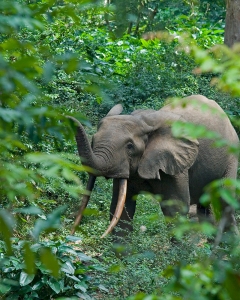Listen Up! Using Passive Acoustic Monitoring to Help Forest Elephant Conservation
Post provided by Peter H. Wrege

Heard but not seen, populations of forest elephants (Loxodonta cyclotis) are rapidly declining due to ivory poaching. As one of the largest land mammals in the world, this species is surprisingly difficult to observe in the dense forests of Central Africa, but their low frequency rumbles can be recorded. With the autonomous recording afforded by passive acoustic monitoring (PAM) though, we have a window onto forest elephant ecology and behaviour that’s providing data critical to their conservation and survival.
The diverse ways that PAM can contribute to conservation outcomes is growing and while still underappreciated, the availability of relatively inexpensive recorders, increased power efficiency, and powerful techniques to automate the detection of signals have led to an explosion in use. In 2007 there were only about 20 published papers using PAM techniques, but since then over 400 papers have appeared in peer-reviewed journals.

Essentially, PAM is the automatic recording of sounds in a given environment, often for long periods. The trick, and often greatest challenge, is to find the signals of interest (bird calls, elephant rumbles, gunshots) within the recordings. With these signals we can quantify abundance, occupancy and spatial or temporal patterns of activity. Particularly in landscapes or ecosystems where visual observation is difficult (e.g. oceans, rainforests, nocturnal environments) PAM may be uniquely capable of delivering informative and unbiased data. Because PAM is a relatively new method but of considerable interest across the disciplines of ecology, behaviour and conservation, there is huge interest in refining the sampling and statistical methods needed to deal with the peculiarities of acoustic data. Continue reading “Listen Up! Using Passive Acoustic Monitoring to Help Forest Elephant Conservation”

 An Asian, female Senior Editor under 45? Progressive! I have loved
An Asian, female Senior Editor under 45? Progressive! I have loved 



